by Martin Green
When it comes to pilot’s watches, IWC pretty much coined the term.
Based on its early military watches (see Exceptional Movements In History: IWC Caliber 89), IWC has created a long lineage of highly successful, instantly recognizable pilot’s watches aimed at the civilian market.
This successful formula has shown very little change over the years, usually with a stainless steel case and occasionally with a few complications thrown in for good measure. Sometimes the case size changes or the shape of the hands are updated, but in general the IWC pilot’s watch formula has been a textbook case of consistency.
And then along came the Mark XVIII Top Gun Miramar, first as a chronograph in 2012 and then as a three-hander in 2016.
Where the former IWC Top Gun watches were generally well received, the Top Gun Miramar changed things up a bit. And not surprisingly the result was far more polarizing.
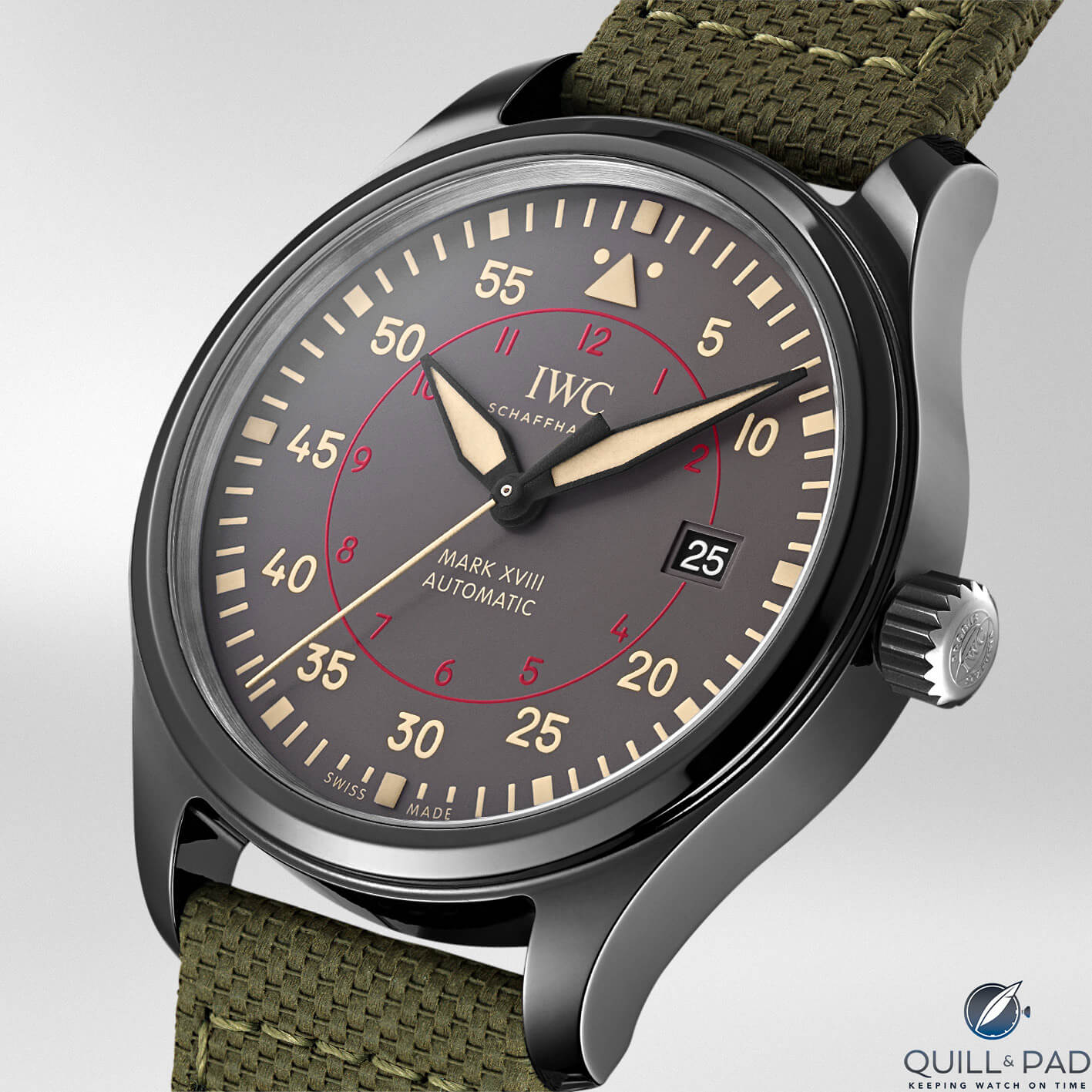
IWC Mark XVIII Top Gun Miramar
Unlike the steel cases of previous models, the Mark XVIII Top Gun Miramar featured a ceramic case that did not have the usual matte finish, but rather a glossy polish. This high-tech case is combined with an anthracite Type B dial displaying a bold minute track while the hours have a more modest position nearer the center of the dial. Add that to beige-colored hands and numerals, a titanium crown, case back and buckle, plus a green calfskin strap, and you have a combination of old and new styling elements putting many consumers at a loss.
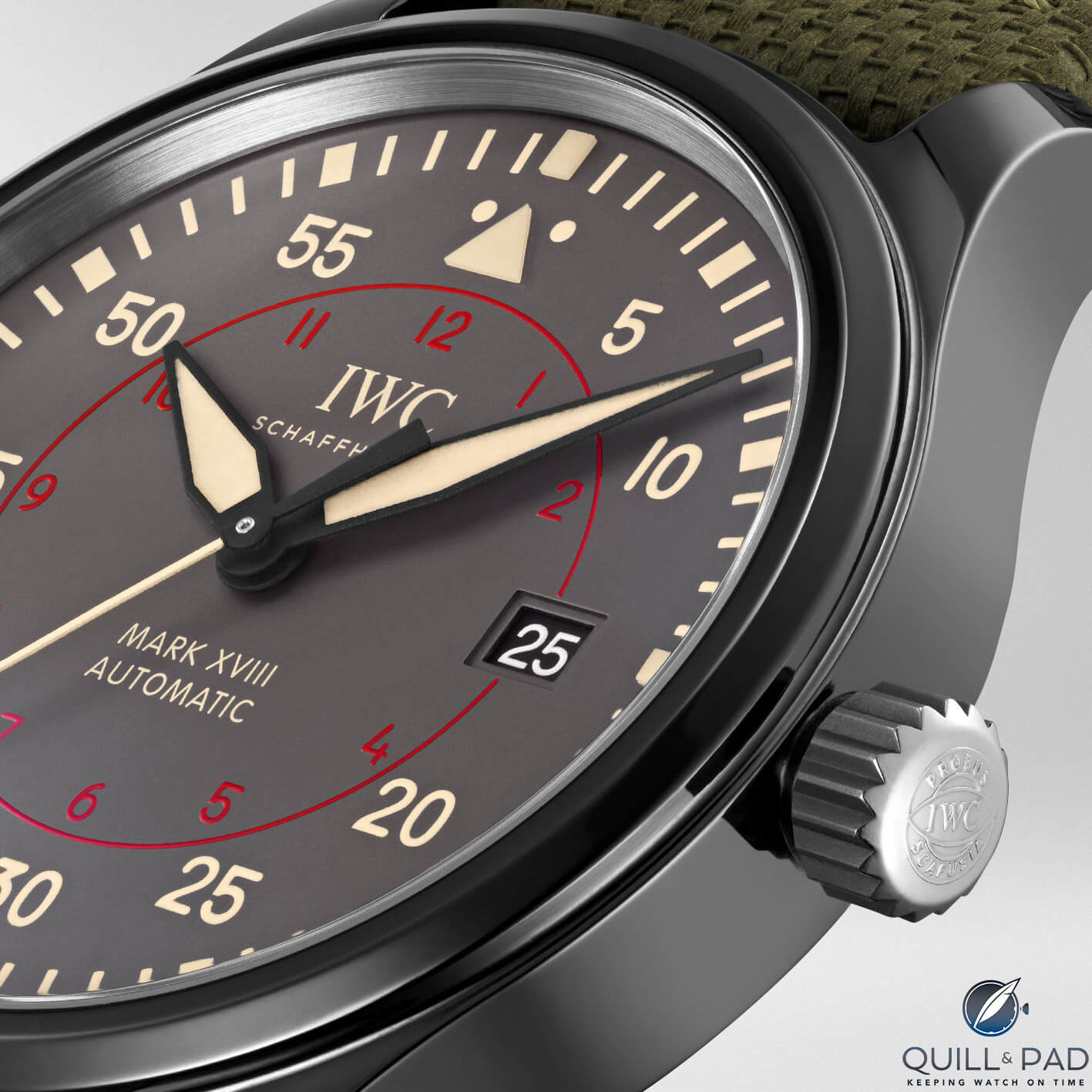
Titanium crown of the IWC Mark XVIII Top Gun Miramar
Storytelling: Miramar vs. Top Gun
In my opinion, the biggest issue with the Mark XVIII Top Gun Miramar is that IWC didn’t get the story across for this watch.
In the minds of many, “Top Gun” is synonymous with Tom Cruise in an F-14 Tomcat fighter jet. Even though this movie is 32 years old, a vintage-inspired dial on a watch called “Top Gun” seems strangely out of place.
That is also because this watch is actually far more related to ”Miramar,” the base north of San Diego that was until 1996 home of the United States Navy Fighter Weapons School, than Top Gun.
The history of Miramar is most certainly interesting enough to warrant a watch dedicated to it. The area was named by Edward Willis Scripps, who bought the land after the American Civil War: “Miramar” is Spanish for “look at the sea.” Although originally from the Midwest, where he owned several newspapers and also founded the United Press news service, Scripps used the land to build a ranch, hoping that the warmer climate would relieve his allergic rhinitis.
The area was used primarily for cattle grazing until the U.S. Army bought a large portion, opening Camp Kearny in 1917. As an army base, it was chiefly utilized to train infantry troops before shipping them out to the bloody battlefields of Europe where World War I was in full swing.
After the Camp Kearny was closed in 1920, it received a first entry in the annals of aircraft history: Charles Lindbergh used the deserted army base to test his famous Spirit of St. Louis, which was made in the area, before embarking on the solo flight across the Atlantic Ocean that would bring him enduring fame.
It wasn’t until World War II that Miramar became a real airfield. As hostilities increased, the base was renovated and reinstated. Now named Camp Elliott and housing several Marine divisions, its first runway was constructed in 1940 and the base became home to the 1st Marine Air Wing.
In 1943 the base started to train the first aircrews when the Navy created a Naval Auxiliary Air Station, which also meant expanding the runways.
After World War II the base was once again named Miramar, and in 1952 its status was upgraded to Naval Air Station (dropping the “auxiliary”). The Air Station experienced a short fling with space flight when it was used for Project Orion, a controversial space program based on the concept of nuclear pulse drive, which basically meant propelling a craft into space by detonating a series of nuclear bombs (what could possibly go wrong there?). NASA also used Miramar for a brief while, thankfully testing more conventional propulsion methods.
However, Miramar didn’t fully bloom until another war broke loose. The Vietnam War left the Navy in need of a training facility that would educate its pilots in the finer points of fleet air defense and dog fighting. In 1969 the United States Navy Fighter Weapons School was founded, calling Miramar its home, and in 1972 it was equipped with the very first F-14 Tomcats.
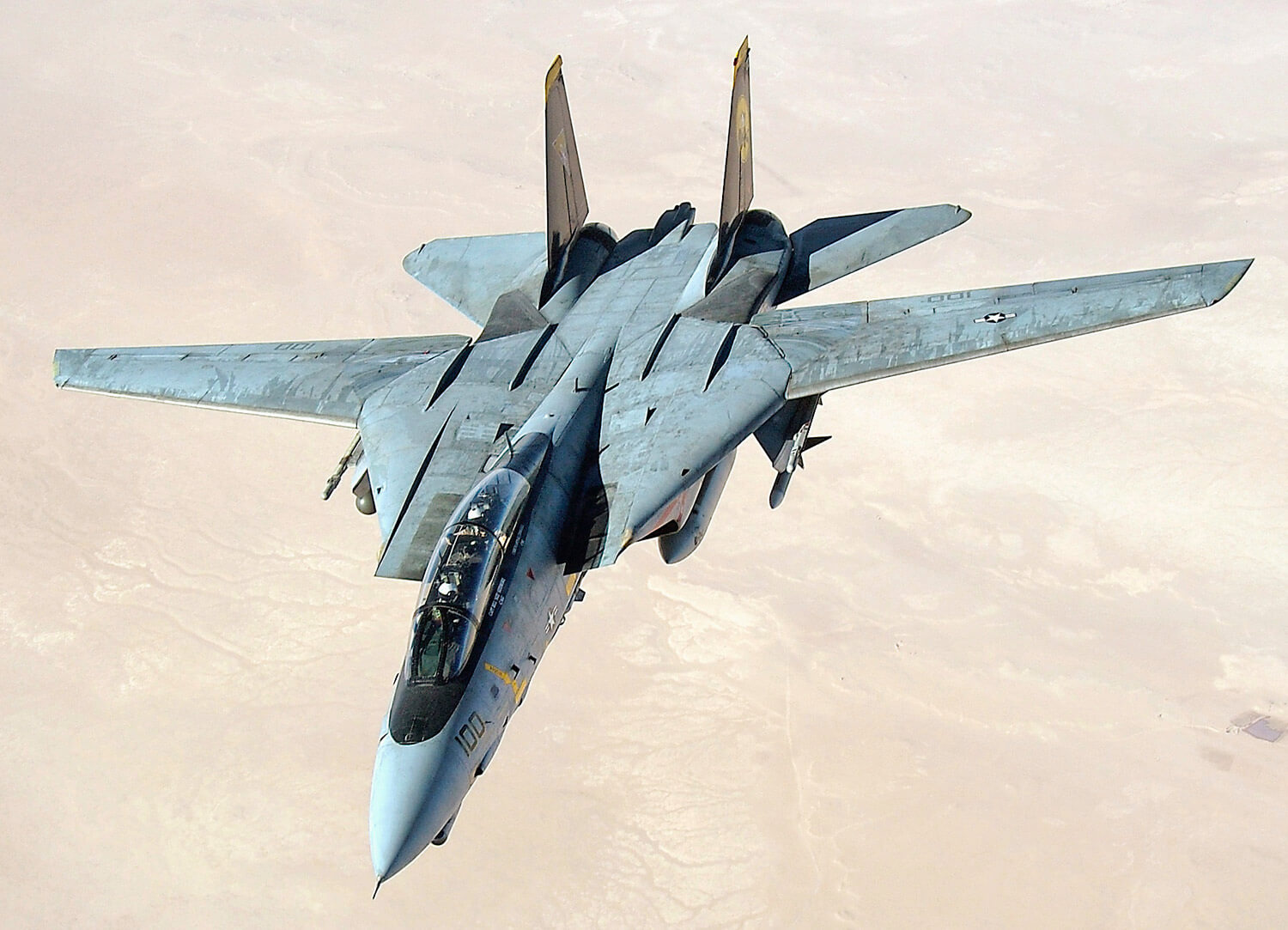
U.S. Navy F-14D Tomcat (photo courtesy Wikipedia)
And thanks to being flown by “Maverick” and “Goose” in the famous 1986 blockbuster, Top Gun, those fighter jets became part of cinematic history – and Miramar with it.
Like in the movie, the United States Navy Fighter Weapons School trains fighter pilots in advanced flying and fighting techniques, but was merged into the Naval Strike and Air Warfare Center in 1996, now operating from Fallon Naval Air Station in Nevada. After the Navy left, Miramar was once again used by the Marines and renamed Marine Corps Air Station Miramar, which it continues to be called today.
To make a long story short, while there is significant military history in the name Miramar it has been over 22 years since it was connected to “Top Gun,” making both names combined in a modern-day watch seem a bit odd.
With the benefit of hindsight, IWC might have called this watch the Mark XVIII Miramar, engraved the back with airfield landing strips instead of the Top Gun logo, and focused on brand history in the marketing.
The watch for what it is
Setting the name aside, what do you actually get with the Mark XVIII Top Gun? Here the tables all of a sudden turn, although you must handle the watch in person to fully appreciate the rotational angle.
The vast majority of IWC’s pilot’s watches feature Type A dials with a triangle at 12 o’clock, a minute track, and Arabic hour markers. The Type B dial, like the Mark XVIII Top Gun Miramar has, is far rarer.
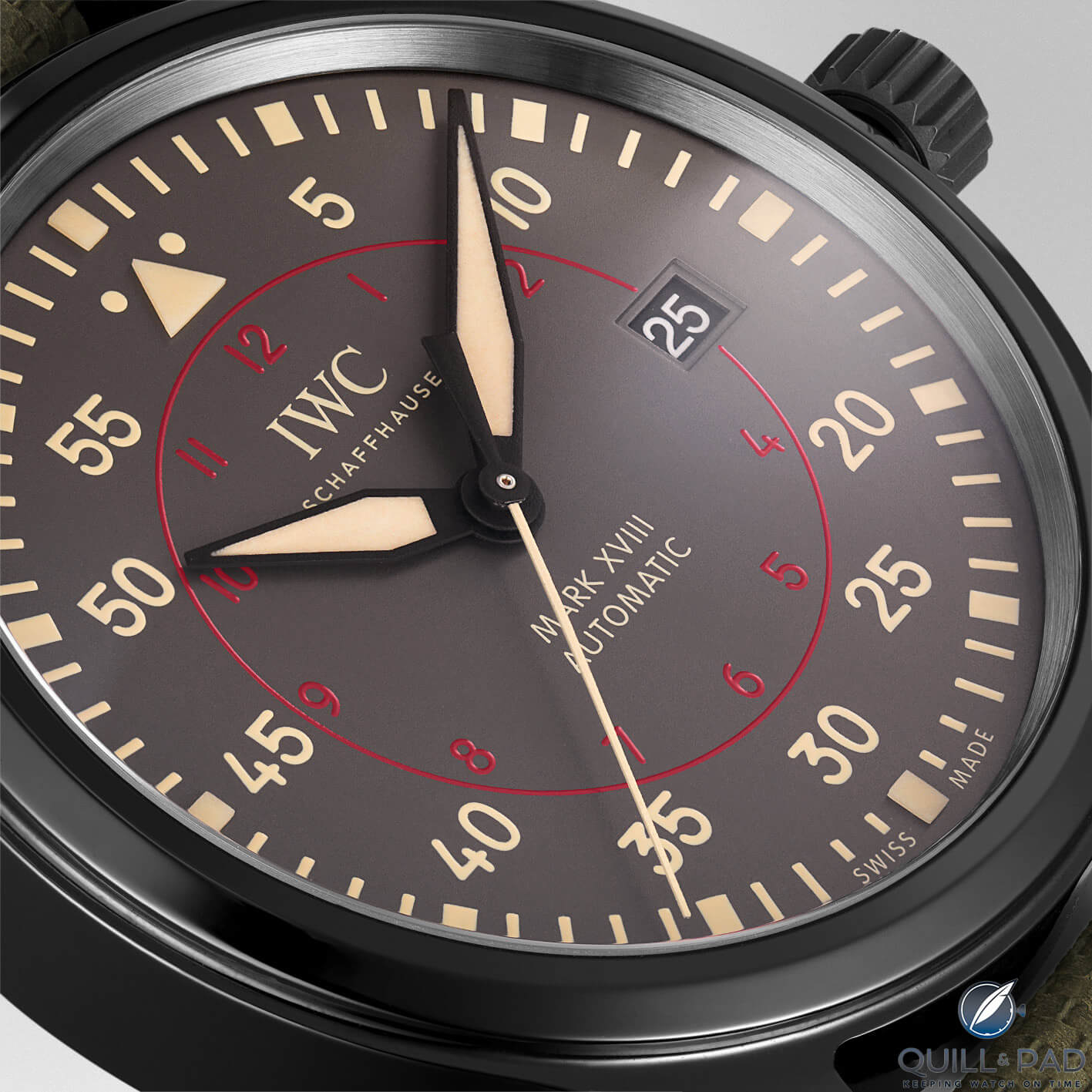
A close look at the dial of the IWC Mark XVIII Top Gun Miramar
IWC also makes the Top Gun Miramar stand out even more by not going for the traditional colors of white on black, but instead using an anthracite-colored dial with beige-colored hands and minute markers, with red to indicate the hours. While you expect that all of the beige surfaces are in fact Super-LumiNova, only the 12, 3, 6, and 9 and the hands light up in the dark.
While some might prefer a more generous use of luminous material, this amount used on the Mark XVIII Top Gun Miramar is historically in line with the watch’s predecessors such as the Mark XII.
The black ceramic case contrasts quite well with the dial, although IWC ties the two cleverly together by means of the black date wheel. The result is like one of those food combinations that shouldn’t taste good together but do. Before actually wearing the watch I was highly skeptical of its polished look; it simply didn’t seem to fit a masculine piece like this IWC pilot’s watch and yet . . . it does.
In fact, while wearing it I even came to prefer the ceramic case over the matte steel version as the case almost seems to change color as it catches different light. Historically, ceramic also has a place in IWC’s “Flieger” lineup as it was first used for the Fliegerchronograph Reference 3705 in 1994 as well as the ceramic-encased Da Vinci models that IWC also made at the time.
Special mention goes to the modern strap, which looks like fabric but is in fact calfskin with a printed pattern. It looks remarkably good, yet does introduce yet a new color to the watch as it is kind of a forest green. It doesn’t really come across as well in photos as it does in real life.
The same can be said for the dial. IWC selected a beautiful domed sapphire crystal for the watch, but applied an anti-reflective coating on both the inside and the outside making it very hard to capture the true color of the dial on film. Personally, I am not a fan of antireflective coating on the outside of any sapphire crystal as it is bound to get damaged or scratched and then looks worse than it would have ever done without applying it at all.
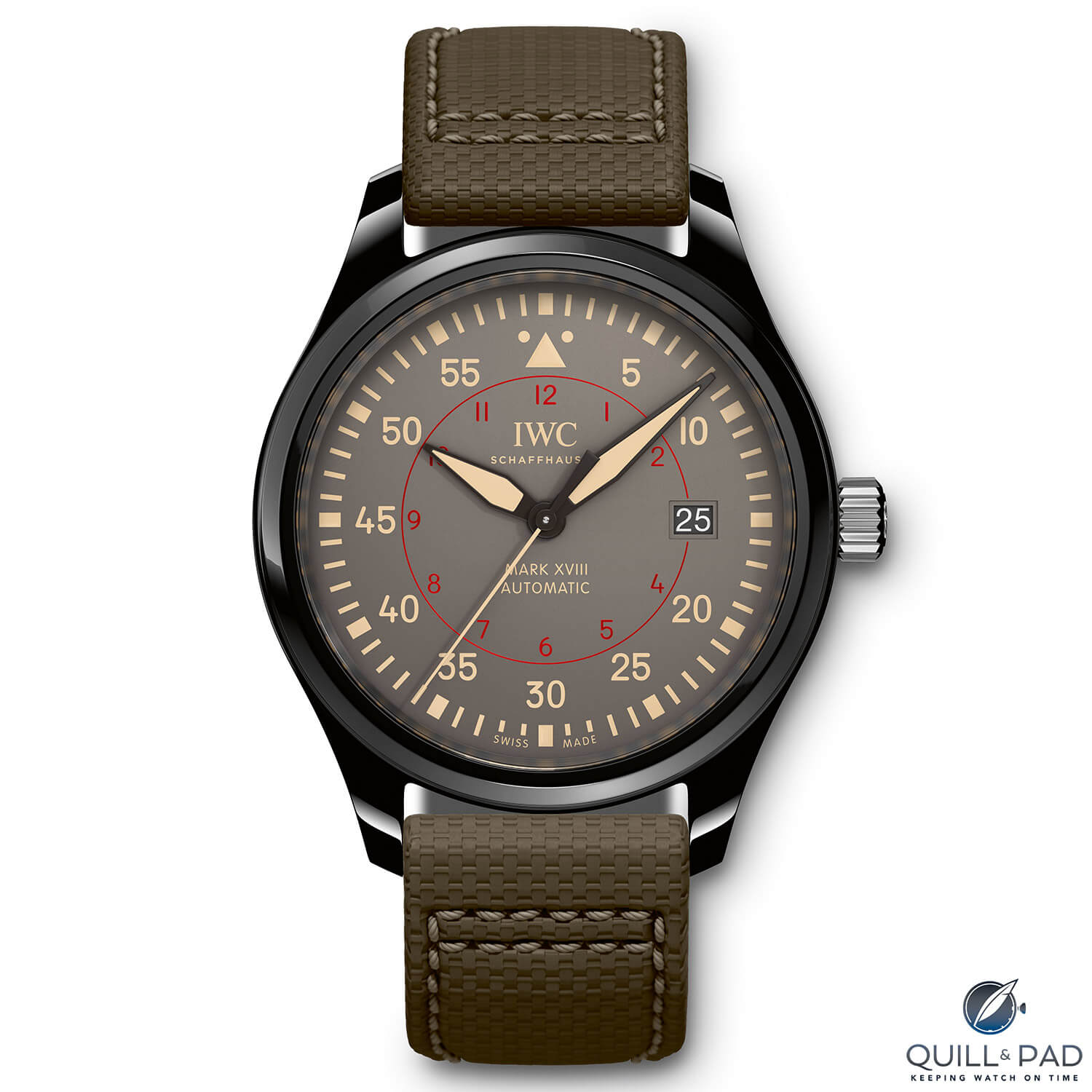
IWC Mark XVIII Top Gun Miramar
The inside track
IWC pilot’s watches aimed at the civilian market really took off in 1993 with the Mark XII powered by Jaeger-LeCoultre’s Caliber 889/2, a beautiful, high-end movement with a more technical finish that became IWC’s Caliber 884/2.
This is only for your watchmaker to enjoy because not only was the Mark XII – just like the Mark XVIII Top Gun Miramar – fitted with a closed case back, it also featured a soft iron inner case to protect the movement’s precision against the detrimental effects of magnetism.
A special edition of the Mark XII made for car manufacturer Saab saw IWC switch over to an ETA caliber that would power following generations of the Mark collection, including the Mark XVIII Top Gun Miramar, which is powered by IWC Calibre 30110, a slightly reworked ETA Caliber 2892.
Personally, I have two minds regarding this. The movement connoisseur in me wants something like the Jaeger-LeCoultre Caliber 889/2, even if it doesn’t really make sense in a pilot’s watch.
But, then again, is this still a pilot’s watch we are talking about?
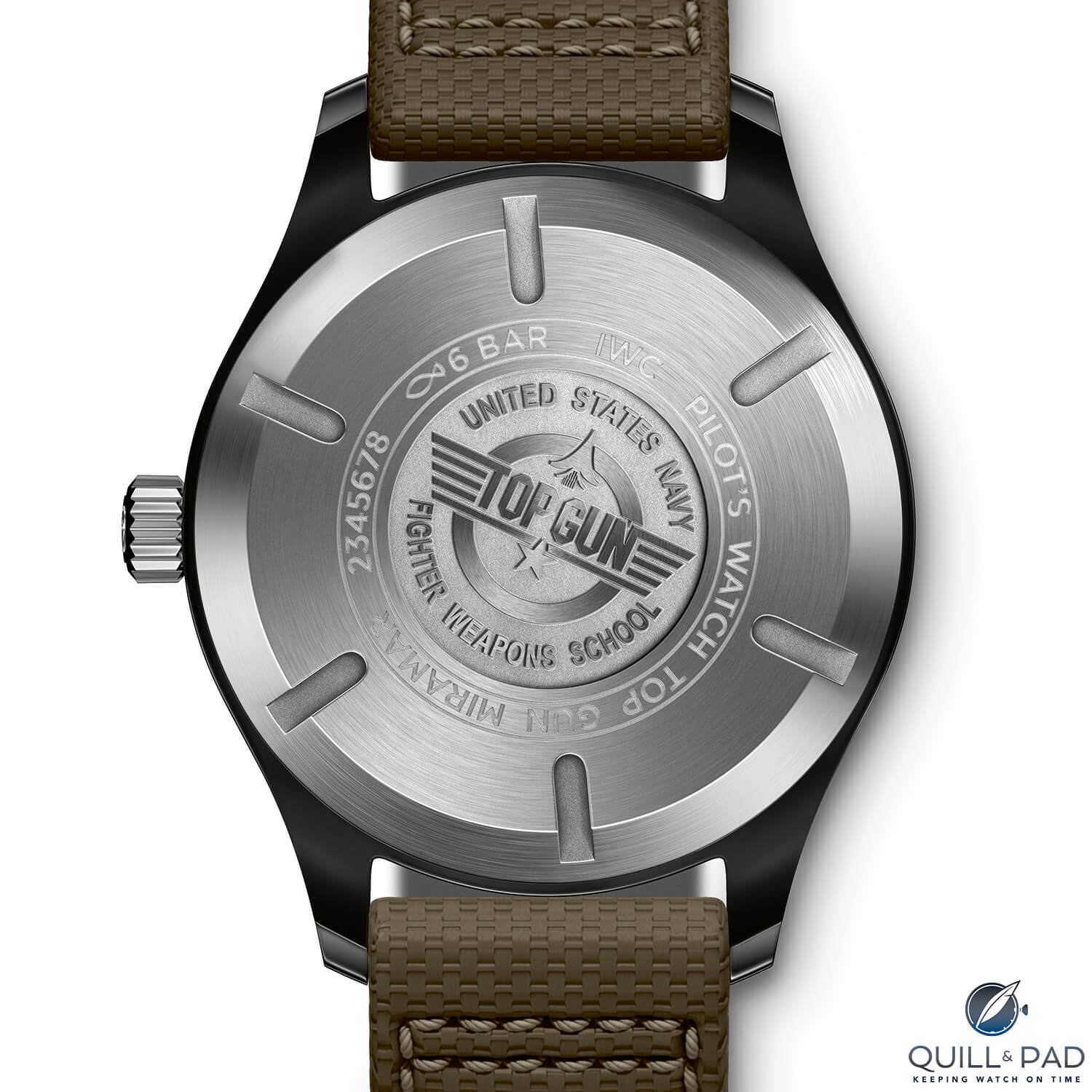
Back of the IWC Mark XVIII Top Gun Miramar
With a price tag of €6,100, it is fair to say that it is more a lifestyle watch than a down-and-dirty tool watch, and that the majority of its owners are more likely to spend the pre-flight check enjoying champagne in first or business class rather than the flight deck.
While you are getting a very dependable and precise automatic movement, it might be time for IWC to step it up in this part of its collection as well. Mind you, Caliber 30110 powers the vast majority of IWC’s time-only watches. Should IWC decide to upgrade, it might even also be able to dispense with the soft iron inner case.
While the soft iron inner case can be seen, and marketed, as a historical touch, brands like Omega, Breguet, Ulysse Nardin, and Rolex (just to name a few) have shown us that most magnetism issues can be solved inside the movement these days.
To buy or not to buy?
For potential buyers, there are quite a few hurdles to overcome before a purchasing decision in favor of the Mark XVIII Top Gun Miramar is likely to happen.
If potential customers are not already confused by the name, they will most likely need to experience the watch in person to be convinced. And then there is the competition, not even so much from other brands, but within IWC’s own pilot’s collection, which is, quite frankly, brutal.
Those preferring a watch with a vintage look and willing to forgo the ceramic case can opt for either the Mark XVIII Heritage or the Mark XVIII Edition Tribute to Mark XI (which, as a side note, looks more like a tribute to the Mark XII).
Both cost significantly less than the Mark XVIII Top Gun Miramar while offering a more “accepted” vintage styling. Those who do want a ceramic case also have the option of the Mark XVIII Edition Laureus to choose from. Not only does the Laureus feature an easygoing black/blue color combination, it’s also a limited edition of 1,500 pieces – for only €200 more than the unlimited Top Gun Miramar.
So the Top Gun Miramar has both serious competition from its own stable and is polarizing, drawing wrath from the IWC pilot watch traditionalists, which seems admittedly bad. However, it was only 2015 when Patek Philippe created a digital firestorm by launching the Calatrava Pilot Travel Time Reference 5524G. A large pilot’s watch? Patek? The Calatrava Pilot Travel Time was a watch that took collectors and connoisseurs way outside their comfort zones: it was an incredibly polarizing watch. Until it wasn’t. It became loved and has even since been a bestseller. “Polarizing” wears off with the initial shock.
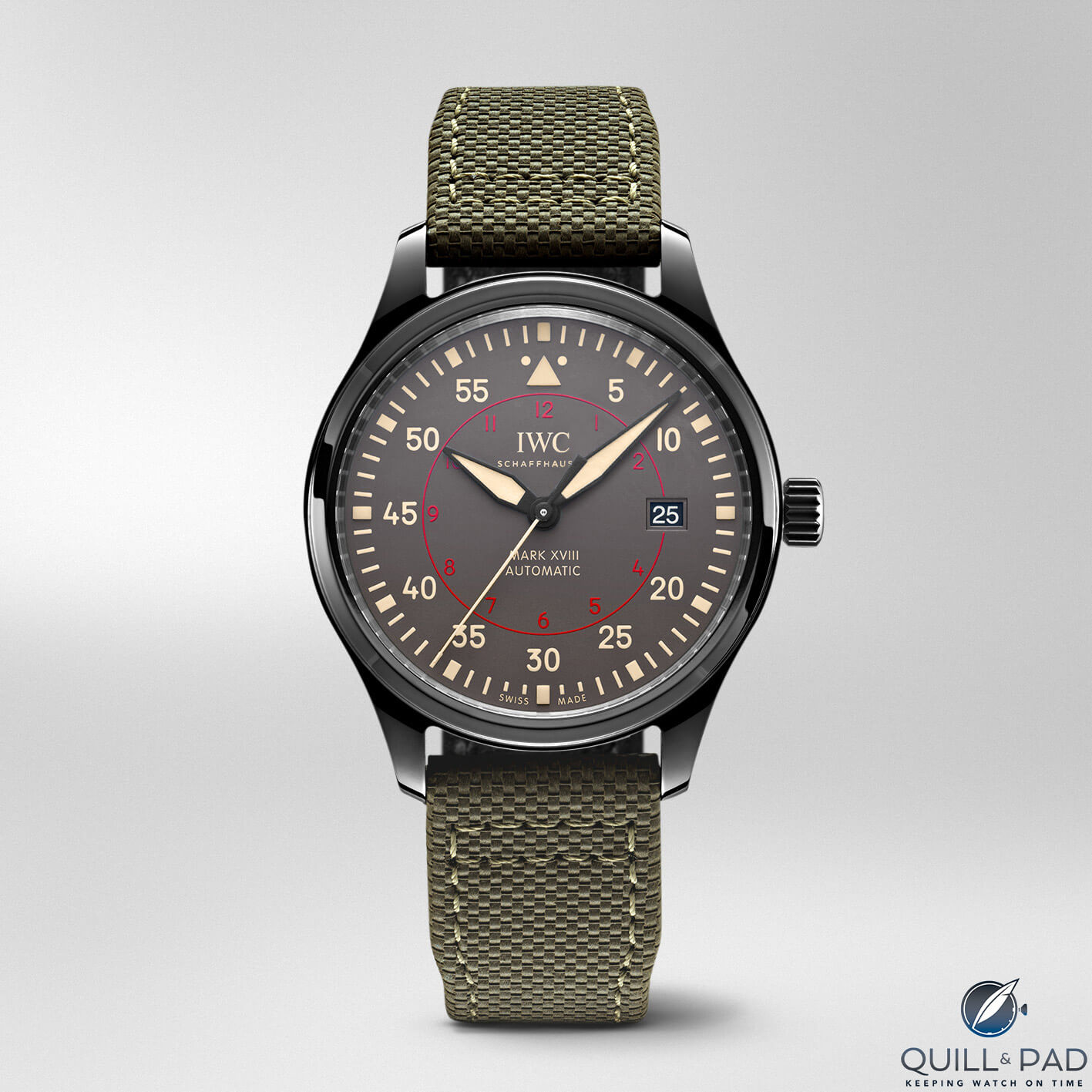
IWC Mark XVIII Top Gun Miramar
The Mark XVIII Top Gun Miramar is polarizing, and there are still many potential customers sitting on the fence. However, this is a watch that’s bound to be a conversation starter with fellow watch connoisseurs.
For more information, please visit www.iwc.com/de/watch-collections/pilot-watches/iw324702-pilot_s-watch-mark-xviii-top-gun-miramar.
Quick Facts IWC Mark XVIII Top Gun Miramar
Case: 41 mm, ceramic
Movement: automatic Caliber 30110 (base ETA 2892-A2), 4 Hz/28,800 vph frequency, 42-hour power reserve, C.O.S.C. chronometer certification
Functions: hours, minutes, seconds; date
Price: €6,100
You might also enjoy:
Exceptional Movements In History: IWC Caliber 89
Leave a Reply
Want to join the discussion?Feel free to contribute!





















































I’m always surprised the Navy doesn’t sue IWC for trademark infringement, but that’s probably because they didn’t trademark the TopGun logo. IWC has absolutely no affiliation nor approval to highjack and use the TopGun and Miramar names. Being a TopGun graduate myself and a mechanical watch lover I contacted IWC multiple times to see if they would be interested in doing a deal with Navy TopGun patch wearers to wear their watches like we’ve done with Omega, Breitling, Fortis, etc.. Received absolutely no response from IWC. So clearly they have no desire to truly be affiliated with what makes TopGun tick: the pilots who learn the and teach the at the highest level of fighter jet tactics. So, I wouldn’t wear an IWC watch if you paid me. Just my two cents.
When IWC launched the Top Gun watches, it held an event on the USS Reagan in connection with the US Navy, which reached a written agreement with IWC to use the name. I did an arrested landing on the aircraft carrier and can furnish photos of the event, incuding of me with Guy “Bus” Snodgrass, a Top Gun Pilot (now retired, and working fir Defense Secretary Mattis) and also the commander of the Pacific Fleet. Unfortunately what Mr. Menna says is incorrect.